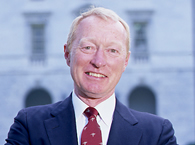News Release: School of Medicine, Woodruff Health Sciences
Feb. 13, 2009
Emory Honors Trustee Emeritus with Naming of James B. Williams Medical Education Building
 James B. Williams
James B. WilliamsEmory University's School of Medicine building will be named for Trustee Emeritus James B. Williams, retired chairman and CEO of SunTrust Banks, Inc.
On Feb. 11, Ben Johnson, chair of the Emory University Board of Trustees, presided over the dedication of the James B. Williams Medical Education Building.
Emory is honoring Williams' 35 years of service on the Emory University Board of Trustees and to the University, and for his leadership on the Woodruff Health Sciences Center Board, the committee of the Board charged with governance of the Woodruff Health Sciences Center, of which the medical school is a part. He chaired the WHSC Board for more than 20 years and continued service on the board until late last year, providing key counsel to a succession of WHSC CEOs, including Charles Hatcher, MD, Michael M.E. Johns, MD, and Fred Sanfilippo, MD, PhD.
"Jimmy Williams is a remarkable leader who always carried forward the vision for Emory's health sciences first supported by his friend and mentor Robert W. Woodruff," says Johnson. "We can think of no better way to honor Jimmy Williams than to put his name prominently on one of the Woodruff Health Sciences Center's most transformative new buildings."

James B. Williams
Medical Education Building
Opened last fall after its construction, the James B. Williams Medical Education Building is located on Pierce Drive, with a courtyard looking toward Emory University Hospital. The modern new building unites the historic anatomy and physiology wings, recently renamed for Charles and Peggy Evans.
The new building gave the medical school its first on-campus home, made possible the implementation of an innovative new curriculum and enabled a 15 percent increase in enrollment, helping alleviate the U.S. physician shortage projected by decade end.
"Jimmy Williams provided visionary leadership through an era of great transformation," says Emory President James W. Wagner. "He successfully chaired Emory University's capital campaign in the 1980s. During the next quarter of a century, he oversaw and helped secure the capital for unprecedented growth in Woodruff Health Sciences Center research, patient care and teaching, while helping steer the patient care enterprise through challenges on which many other institutions floundered."
Sanfilippo, executive vice president for health affairs and CEO of the Woodruff Health Sciences Center since 2007, says, "Jimmy Williams was deeply involved in the extensive building and renovation plan now underway along the Clifton Corridor and the Emory Midtown campus. It's fitting that his work on this transformational project be recognized in one of the first great buildings to be completed."
Thomas J. Lawley, MD, dean of Emory's School of Medicine says, "Naming this important facility the James B. Williams Medical Education Building is an honor for the medical school, as well as a tribute to a man whose leadership contributed to the medical school's dramatic rise to one of the nation's top 20 research-oriented medical schools."
Jimmy Williams graduated from Emory College in 1955. Joining the Trust Company of Georgia, he quickly rose through the ranks to become its president.
In 1979, Robert Woodruff, legendary leader of The Coca-Cola Company, made Williams a member of the Coca-Cola Board of Directors and asked him to chair Emory University's capital campaign, to which the Emily and Ernest Woodruff Foundation had just given $105 million, then the largest gift to an educational institution in history.
Williams had become an Emory Trustee in 1973. Now Emory effectively became his second job, even as he led the Trust Company to remarkable profitability, and then took on the expanded job as president and CEO of SunTrust Banks. In 2004, Williams received an honorary doctorate from Emory and was chosen as Trustee of the Year by Modern Healthcare and Witt/Kieffer executive search firm.
Doug Ivester, who followed Williams as chair of the Woodruff Board in 2003, describes Williams' legacy, "one to which all of us aspire: demonstrated business acumen, exceptional organizational ability, extraordinary motivational skills and the ability to listen intently and then ask the hard questions. As Trustee Emeritus, he still does it, and we still listen."
More about Williams' role at Emory
- Williams provided counsel as Emory expanded its healthcare program. In 1991, under the leadership of Woodruff Health Sciences Center Director Charles R. Hatcher, MD, Emory first created a loose confederation of clinical components and began to accept patients without referral. In 1997, under the leadership of Woodruff Health Sciences Center CEO Michael M.E. Johns, MD, all of Emory's healthcare components were further consolidated. With The Emory Clinic, Emory Children's Center, Emory University Hospital, Emory Crawford Long Hospital and Wesley Woods Center fully integrated under one umbrella, Emory Healthcare became the largest, most comprehensive healthcare system in the state. Williams then encouraged the university to make a $280 million investment to redevelop and expand Emory Crawford Long Hospital, now known as Emory University Hospital Midtown.
- Williams also encouraged expansion of research, with construction of the O. Wayne Rollins Research Center and the Vaccine Center and Neurosciences Center at Yerkes. In 1996, Williams became founding chair of the Woodruff Fund, Inc., created from a $295 million gift of stock from the Woodruff, Whitehead, and Evans Foundations. The Woodruff Fund enabled construction of the Whitehead Biomedical Research Building and a new building for the Emory Winship Cancer Institute that combines research with patient care. Most recently Mr. Williams and the Woodruff Foundation helped support the construction of the Emory Children's Center building that houses the Department of Pediatrics and its clinics and labs. During Williams' tenure, health sciences research funding more than quadrupled.
- Williams' counsel was critical during closure of Emory's dental school and launching of Rollins School of Public Health, now among the nation's top five public health schools. He also oversaw construction of a new Nell Hodgson Woodruff School of Nursing building.
- Drawing on his own high ethical standards and his commitment to the community, Williams worked to continue the Woodruff Health Sciences Center's role as the provider of a major part of indigent care in the region, including charitable care through Emory Healthcare and indigent care provided by Emory doctors at Grady Memorial Hospital.
###
The Robert W. Woodruff Health Sciences Center of Emory University is an academic health science and service center focused on missions of teaching, research, health care and public service. Its components include schools of medicine, nursing, and public health; Yerkes National Primate Research Center; the Emory Winship Cancer Institute; and Emory Healthcare, the largest, most comprehensive health system in Georgia. The Woodruff Health Sciences Center has a $2.3 billion budget, 17,000 employees, 2,300 full-time and 1,900 affiliated faculty, 4,300 students and trainees, and a $4.9 billion economic impact on metro Atlanta.
Learn more about Emory’s health sciences:
Blog: http://emoryhealthblog.com
Twitter: @emoryhealthsci
Web: http://emoryhealthsciences.org
